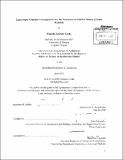Lightweight concrete : investigations into the production of variable density cellular materials
Author(s)
Cooke, Timothy Graham
DownloadFull printable version (30.16Mb)
Other Contributors
Massachusetts Institute of Technology. Department of Architecture.
Advisor
John Fernandez.
Terms of use
Metadata
Show full item recordAbstract
This research focuses on the intersection between material composition and form in the development of a new type of concrete. As concrete is the most widely used building material in the world, innovation in this material has more potential to effect change in our built environment than innovation in any other. With the objective of minimizing raw material consumption and energy use, this work attempts to develop methods for creating a cellular lightweight concrete with variable density that can be cured at room temperature. Most aerated concretes traditionally require high temperature and high pressure curing; the goal of this research is to create a lower embodied energy product through the use of room temperature curing, while at the same time maximizing performance through variation of the density of the material through its section-essentially locating stronger material where it is needed. This more durable and versatile concrete product will be able to compete with traditional lightweight concretes, which provide benefits such as insulation, as well as normal-weight concrete, which is harder and stronger. The research aims to capitalize on the inherent heterogeneity of the material by producing a substance whose internal properties can be varied based on the needs of a specific part of a building. I am interested in replacing the concept of the "assembly" of materials to gain a desired function with a more unitary concept: the manipulation of a single material to meet a building's multiple needs. A desired outcome of the work is to reconceive how we put buildings together, not as assemblies of discrete elements but as monolithic yet malleable wholes.
Description
Thesis (S.M.)--Massachusetts Institute of Technology, Dept. of Architecture, 2012. Cataloged from PDF version of thesis. Includes bibliographical references (p. 123-127).
Date issued
2012Department
Massachusetts Institute of Technology. Department of ArchitecturePublisher
Massachusetts Institute of Technology
Keywords
Architecture.